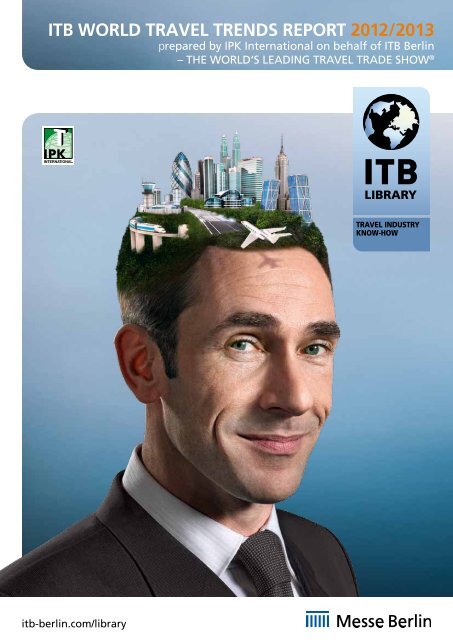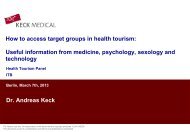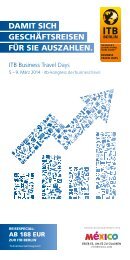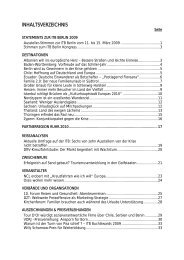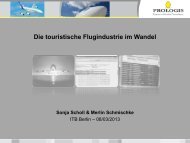ITB World Travel Trends Report 2012/2013 (PDF, 1.8 MB) - ITB Berlin
ITB World Travel Trends Report 2012/2013 (PDF, 1.8 MB) - ITB Berlin
ITB World Travel Trends Report 2012/2013 (PDF, 1.8 MB) - ITB Berlin
You also want an ePaper? Increase the reach of your titles
YUMPU automatically turns print PDFs into web optimized ePapers that Google loves.
<strong>ITB</strong> WORLD TRAVEL TRENDS REPORT <strong>2012</strong>/<strong>2013</strong><br />
prepared by IPK International on behalf of <strong>ITB</strong> <strong>Berlin</strong><br />
– THE WORLD‘S LEADING TRAVEL TRADE SHOW ®<br />
itb-berlin.com/library
<strong>ITB</strong> WORLD TRAVEL TRENDS REPORT December <strong>2012</strong><br />
Copyright ©<strong>2012</strong> Messe <strong>Berlin</strong> GmbH<br />
All rights reserved. The contents of this report may be quoted, provided the source is given<br />
accurately and clearly. Distribution or reproduction in full or in part is permitted for own<br />
or internal use only.<br />
The presentation of material in this publication and the designations employed do not imply<br />
the expression of any opinions whatsoever on the part of Messe <strong>Berlin</strong> or any of its components<br />
or agents.<br />
Prepared on behalf of <strong>ITB</strong> <strong>Berlin</strong> by:<br />
IPK International<br />
Gottfried-Keller Strasse 20<br />
D-81245 Munich<br />
Germany<br />
Contact: Barbara Postel, Senior Consultant<br />
Tel.: +49 89 8292 370<br />
Fax: + 49 89 8292 3726<br />
Website: www.ipkinternational.com<br />
Email: info@ipkinternational.com<br />
Published and printed by:<br />
Messe <strong>Berlin</strong> GmbH<br />
Messedamm 22<br />
D-14055 <strong>Berlin</strong><br />
Germany<br />
Contact: Astrid Zand, Press Officer<br />
Tel.: +49 30 3038 2275<br />
Fax: +49 30 3038 2141<br />
Website: www.messe-berlin.de<br />
Email: ehring@messe-berlin.de<br />
www.itb-library.com<br />
Printed on environmentally-friendly paper
<strong>ITB</strong> WORLD TRAVEL TRENDS REPORT <strong>2012</strong>/13<br />
Foreword<br />
Contents<br />
Foreword......................................................................................................................... 3<br />
A <strong>World</strong> trends: Global tourism defies numerous crises........................................... 4<br />
B Stable growth for European tourism in <strong>2012</strong>........................................................ 9<br />
C Asia drives world tourism growth.......................................................................... 12<br />
D North America flat but South America soars......................................................... 16<br />
E Tourism trends: <strong>Travel</strong>lers want more individual holiday experiences................ 18<br />
F Cruises: Expert calls on industry to change course................................................ 19<br />
G Adventure travel heads for new horizons............................................................. 21<br />
H Medical tourism: Sun, sea and … surgery.............................................................. 23<br />
I Making tourism more accessible............................................................................ 25<br />
J Social media and bloggers become major influences on travel behaviour......... 27<br />
Dear reader,<br />
This <strong>ITB</strong> <strong>World</strong> <strong>Travel</strong> <strong>Trends</strong> <strong>Report</strong> <strong>2012</strong>-13 was again<br />
commissioned by <strong>ITB</strong> <strong>Berlin</strong> from IPK International,<br />
organisers of the 20th annual <strong>World</strong> <strong>Travel</strong> Monitor<br />
Forum, held at the medieval Villa di Corliano in San<br />
Giuliano Terme, near Pisa, Italy, in late October <strong>2012</strong>.<br />
The report covers the main trends in outbound travel<br />
demand for the first eight months of <strong>2012</strong> together<br />
with estimates for the full year and also contains initial<br />
forecasts for <strong>2013</strong>, as presented at the Pisa Forum<br />
(as it is widely known).<br />
In addition, it focuses on various topics and market segments that were discussed at the Forum.<br />
These include the role of technology and social media, the challenges facing the cruise business,<br />
niche markets such as adventure travel and medical tourism, and the need for better accessibility<br />
for people with disabilities.<br />
As the following sections make clear, the world travel industry again proved its resilience and<br />
ability to overcome crises this year. Despite many different negative factors, the travel and tourism<br />
industry is expected to reach a new all-time high in <strong>2012</strong>. According to IPK’s <strong>World</strong> <strong>Travel</strong><br />
Monitor, outbound (international) trips will increase by 4% in <strong>2012</strong>, which is only slightly lower<br />
than last year’s 5% growth figure. This is an impressive result.<br />
And the outlook for next year is quite respectable, too, even though there is significant uncertainty<br />
about the global economy. <strong>World</strong> outbound travel is expected to grow in the 2-3% range,<br />
which would be very solid growth in the present circumstances and would again demonstrate<br />
the sector’s proven stability and long-term growth record. The main drivers are likely to be Asia<br />
and other emerging markets, but Europe is also expected to show low positive growth in <strong>2013</strong>.<br />
As usual, the Pisa Forum was organised in co-operation with the European <strong>Travel</strong> Commission<br />
(ETC) in Brussels, whose Executive Director Eduardo Santander stressed the importance of such<br />
co-operations. Some 50 experts from around the world, including all regions of Europe, along<br />
with North and South America and parts of Asia-Pacific, took part. They represented international<br />
organisations, national and regional tourism organisations and associations, international<br />
research institutes and private companies from travel and tourism and related sectors.<br />
<strong>ITB</strong> <strong>Berlin</strong> is delighted to continue its close association with IPK International and the Pisa Forum<br />
for the eighth consecutive year. In March <strong>2013</strong> at the <strong>ITB</strong> <strong>Berlin</strong> Convention, Rolf Freitag will present<br />
updated figures for <strong>2012</strong> as well as current forecasts for <strong>2013</strong>.<br />
Meanwhile, we wish you happy reading!<br />
Dr Martin Buck David Ruetz Rolf Freitag<br />
Vice President <strong>Travel</strong> & Logistics Head of <strong>ITB</strong> <strong>Berlin</strong> President & CEO<br />
Messe <strong>Berlin</strong><br />
IPK International<br />
2<br />
3
<strong>ITB</strong> <strong>World</strong> <strong>Travel</strong> <strong>Trends</strong> <strong>Report</strong><br />
<strong>ITB</strong> <strong>Berlin</strong> & IPK International / December <strong>2012</strong><br />
Section A: <strong>World</strong> <strong>Travel</strong> <strong>Trends</strong><br />
Global tourism defies<br />
numerous crises<br />
People around the world still want to travel despite the global financial<br />
and economic crisis, and the tourism industry once again proved its resilience<br />
and ability to overcome the impact of negative external factors<br />
this year. International travel is expected to reach a new all-time high in<br />
<strong>2012</strong> and then grow moderately in <strong>2013</strong>, driven by emerging markets.<br />
These were the key messages from the 20th <strong>World</strong> <strong>Travel</strong> Monitor Forum,<br />
held in Pisa in late October <strong>2012</strong>.<br />
According to IPK International’s <strong>World</strong> <strong>Travel</strong> Monitor, a total of 6.8 billion<br />
trips will take place this year, 2.5% more than in 2011. Domestic travel<br />
will grow by 2% to reach 5.77 billion trips while international travel will<br />
rise by 4% to 1.03 billion trips. This forecast is in line with the expectations<br />
of the <strong>World</strong> Tourism Organization (UNWTO) which sees a 3-4%<br />
rise in international tourist arrivals in <strong>2012</strong>. These figures match the forecasts<br />
for <strong>2012</strong> made at last year’s Pisa forum, underlining the event’s<br />
proven forecasting accuracy.<br />
Looking ahead to <strong>2013</strong>, IPK expects world tourism to show its resilience<br />
once again with international trips growing in the 2-3% range while the<br />
UNWTO is predicting a 2-3% rise in international arrivals. This moderate<br />
but solid growth demonstrates that world tourism is remarkably stable<br />
despite slow global economic growth and the impact of the eurozone<br />
crisis and other factors. “More people plan to travel next year and we<br />
can expect modest but satisfactory growth in <strong>2013</strong>,” said Rolf Freitag,<br />
CEO of IPK International.<br />
<strong>World</strong> travel trends (change (in %) over respective previous year)<br />
Shorter trips<br />
but higher spending<br />
in <strong>2012</strong><br />
<strong>Travel</strong>lers are older<br />
and book online<br />
more than ever<br />
<strong>World</strong> travel was hit by a diverse mix of bad news and events this year,<br />
including severe weather around the world, political conflicts, the depressed<br />
global economy and soaring energy prices, Rolf Freitag, CEO of<br />
IPK International, told forum participants. But emerging markets continued<br />
to provide good news with rising salaries and upward mobility<br />
combining to generate growing tourism demand, he stressed.<br />
Overall, international trips are expected to show 4% growth this year<br />
but overnight stays will only increase 2%, reflecting the continuing trend<br />
to shorter trips, the <strong>World</strong> <strong>Travel</strong> Monitor results showed. In contrast,<br />
global travel spending grew healthily by 7% to €875 billion, resulting in<br />
a 3% increase in spending per trip and a 5% rise in average spending per<br />
night (due to shorter average trips). Asians, South Americans and North<br />
Americans spend the most per trip, partly due to higher flight costs,<br />
while European spending is lower on average.<br />
The USA remains the world’s top destination for international travel with<br />
56 million visitors, ahead of Spain (51m) and Germany (48m), according<br />
to the international tourism experts at IPK. The other top 10 destinations<br />
in 2011 were France, Italy, China, the UK, Austria, Mexico and Turkey.<br />
<strong>Travel</strong>lers are also getting older, the <strong>World</strong> <strong>Travel</strong> Monitor showed. The<br />
number of travellers aged 55+ has increased to 23%, while 35% are in<br />
the 15-34 age category and 42% are aged between 35 and 54. Holidays<br />
remain the dominant reason for taking an international trip (71%), ahead<br />
of business travel 16% and other reasons such as visiting friends and relatives<br />
(13%). More people are flying on holiday than using their car or<br />
another means of transport.<br />
2009 2010 2011 <strong>2012</strong><br />
All trips -1% +5% +3% +2.5%<br />
Outbound trips -4% +7% +5% +4%<br />
Outbound nights -7% +5% +4% +2%<br />
The internet has now clearly established itself as the main place to buy<br />
travel with 54% of bookings, well ahead of travel agencies which have<br />
slipped back to 24%. Interestingly, this is a global trend with Asians and<br />
South Americans now catching up with North Americans and Europeans<br />
in terms of booking via the web, the IPK figures showed.<br />
Outbound<br />
spending in €<br />
Source: <strong>World</strong> <strong>Travel</strong> Monitor <strong>2012</strong><br />
-9% +7% +8% +7%<br />
South America and<br />
Asia drive global<br />
travel growth<br />
The fastest-growing region this year was South America with a 12% increase<br />
in outbound trips to a new all-time high, the <strong>World</strong> <strong>Travel</strong> Monitor<br />
showed. However, growth rates in the region are now slowing as demand<br />
in Brazil in particular cools off (see Section D for further details). Africa<br />
also showed very healthy growth with a 9% rise in outbound travel, although<br />
from a smaller base level.<br />
4<br />
5
<strong>ITB</strong> <strong>World</strong> <strong>Travel</strong> <strong>Trends</strong> <strong>Report</strong><br />
<strong>ITB</strong> <strong>Berlin</strong> & IPK International / December <strong>2012</strong><br />
Asia Pacific again proved to be a reliable motor for world travel with a<br />
7% rise to a new all-time high. One key factor was a very strong comeback<br />
by Japan, which registered a 13% increase in international trips after<br />
a 7% decline in 2011 due to the impact of the March earthquake disaster<br />
on travel demand. China and smaller Asian markets also grew<br />
strongly this year (see Section C for further details).<br />
Rolf Freitag, CEO of IPK International, said: “The continuing upward<br />
trend in the global travel industry is due mainly to an economic boom in<br />
the BRIC countries - Brazil, Russia, India, China and in other developing<br />
countries. Significant income growth in countries such as Russia and India<br />
and the emergence of a new middle class in almost every BRIC country<br />
has sparked a desire to travel which prevails in times of crisis.”<br />
<strong>World</strong>wide, only 39% of the participants in the IPK study said the financial<br />
crisis would affect their plans for international travel, as opposed to<br />
40% last year. Even more positively, 28% say they plan to travel more,<br />
compared to 23% last year; 41% about the same (40% in 2011) and just<br />
21% plan to travel less (23% last year). Overall, IPK predicts 2-3% growth<br />
in outbound travel next year, driven once again by emerging markets.<br />
The two largest regions by market size, North America and Europe, also<br />
grew this year but at relatively low rates. North American outbound travel<br />
increased by 3%, with short-haul travel declining 1% but long-haul<br />
travel growing by 6%. Europe showed moderate growth of just 2% but<br />
with a very diverse pattern depending on local market conditions. Some<br />
markets have still not yet recovered to their previous all-time high levels<br />
registered back in 2008 (see Sections B and D for further details).<br />
<strong>World</strong> regional travel trends<br />
(change (in %) over respective previous year)<br />
2011 <strong>2012</strong> <strong>2013</strong> forecasts<br />
<strong>World</strong> +5% +4% +2-3%<br />
Europe +4% +2% +2%<br />
N. America -1% +3% +0% (US)<br />
More travel in <strong>2013</strong><br />
despite uncertainties<br />
Asia Pacific +6% +7% +6%<br />
S. America +7% +12% +2% (Brazil)<br />
Source: <strong>World</strong> <strong>Travel</strong> Monitor <strong>2012</strong><br />
According to Rolf Freitag, <strong>2013</strong> has many unknown risks in store. “Besides<br />
existing challenges such as the European debt crisis, drastic rises in energy<br />
costs and in some cases food costs will also impact significantly on the<br />
travel industry.“ However, he added that people were more relaxed<br />
about such crises than in previous years.<br />
UNWTO sees 3-4%<br />
growth in international<br />
arrivals in <strong>2012</strong><br />
The UNWTO gave a similar outlook, predicting that international arrivals<br />
would grow by 3-4% to more than one billion for the first time this year.<br />
For <strong>2013</strong>, the UNWTO forecasts a slight slowdown in demand to growth<br />
of 2% to 4%. Michel Julian, UNWTO representative in Pisa, told the forum<br />
that the global tourism industry has so far proved resilient in the<br />
face of the current economic situation. “That is quite remarkable, especially<br />
in view of the current economic challenges around the world,” he<br />
commented. According to UNWTO, emerging countries in Asia and the<br />
Americas in particular will contribute to this year’s increase, whereas<br />
growth in Europe and North America is expected to continue at a more<br />
moderate pace.<br />
6<br />
7
<strong>ITB</strong> <strong>World</strong> <strong>Travel</strong> <strong>Trends</strong> <strong>Report</strong><br />
<strong>ITB</strong> <strong>Berlin</strong> & IPK International / December <strong>2012</strong><br />
Section B: European travel trends<br />
Hotels report higher<br />
prices and mixed<br />
occupancy levels<br />
Hotels around the world are generally<br />
having a good year in <strong>2012</strong><br />
with demand outpacing supply and<br />
higher average prices as a result,<br />
Naureen Ahmed, forecast analyst<br />
at leading hospitality research company<br />
STR Global, told the forum.<br />
Occupancy levels and average daily<br />
rates (ADR) have improved by moderate<br />
single-digit rates in most<br />
world regions over the first nine<br />
months of this year.<br />
In North America, demand is well ahead of supply, resulting in better<br />
occupancy levels and higher prices. In Asia and the Middle East, demand<br />
is healthily ahead of supply, also resulting in higher average levels of occupancy<br />
and price. In Central & South America, supply is running ahead of<br />
demand, resulting in low occupancy levels although prices remain stable.<br />
Africa is seeing better occupancy rates so far this year as demand recovers<br />
but prices have dropped back.<br />
However, the picture is more mixed in Europe. Average occupancy stagnated<br />
as supply outpaced demand but average prices rose, driven by<br />
events such as the London Olympics and European football championship<br />
in Poland and Ukraine. In general, hotels in Western Europe have seen<br />
stable low growth this year, Central & Eastern Europe is growing healthily<br />
from a low level but Southern Europe is struggling, she pointed out.<br />
Looking ahead to <strong>2013</strong>, Ahmed said that most major cities can expect<br />
moderate growth next year with higher room yields (revenue per available<br />
room). Among the winners will be large cities in Europe, the USA and<br />
Asia, while cities such as London, Madrid, Warsaw, Tokyo and Dubai will<br />
be among the losers for diverse reasons.<br />
Stable growth for<br />
European tourism<br />
in <strong>2012</strong><br />
Long-haul travel<br />
outpaces holidays<br />
within Europe<br />
Europeans continued to travel this year despite the gloomy economic<br />
conditions in many parts of the continent and IPK currently expects another<br />
year of low but positive growth in <strong>2013</strong>. Inbound tourism in Europe<br />
generally shook off the diverse external challenges with low growth this<br />
year, although some destinations suffered from a downturn, and a similar<br />
trend is expected for <strong>2013</strong>, according to experts at the Pisa forum.<br />
The overall number of international trips by Europeans increased 2%<br />
between January and August, the European <strong>Travel</strong> Monitor showed.<br />
Spending also rose by 2% while total overnight stays remained stable.<br />
There were some important trends and shifts within these overall figures,<br />
however. Significantly, the largest market segment – holidays – did<br />
not grow, and beach holidays even declined 1%. In contrast, there was a<br />
14% rise in city trips and business travel grew by 8%. There was a 10%<br />
rise in short trips of 1-3 nights and a 2% drop in longer trips, resulting in<br />
a 3% fall in the average length of trip.<br />
Short-haul travel within Europe and to North Africa grew by a moderate<br />
2%. In general, destinations in northern, central and eastern Europe grew<br />
above-average and western European destinations showed stable demand<br />
but there was a drop in demand for some southern European destinations<br />
while North Africa recovered strongly with a 15% increase in<br />
European visitor numbers.<br />
Greece, for example, suffered a 12% drop in incoming tourism from Europe,<br />
especially from Germany and the UK, where travel to Greece dropped<br />
about 20-30%. This was partly compensated by more Russian tourists.<br />
The picture was better for Italy (+2%) with more visitors from<br />
eastern Europe (e.g. Russia and Poland) compensating for fewer German<br />
and British visitors (-3% and -1% respectively). The picture was similar for<br />
Spain (+3%) which saw strong increases from Russia and Scandinavia,<br />
more British tourists (+5%) but stagnating German visitor numbers. Portugal<br />
(+3%) had more Russian, Scandinavian and German visitors this<br />
year.<br />
Long-haul destinations were popular for Europeans this year with a healthy<br />
4% increase in trips to overseas destinations, the European <strong>Travel</strong> Monitor<br />
showed. Europeans travelled more to the Americas (+2%) and above all to<br />
Asia Pacific, with the number of trips to the region rising by 8%.<br />
Russia booms but<br />
Italians and Spaniards<br />
stay at home<br />
In a period of widespread economic uncertainty and even turmoil in some<br />
countries, European source markets showed divergent travel patterns this<br />
year, IPK analyst Stephanie Grothe told the forum.<br />
8<br />
9
<strong>ITB</strong> <strong>World</strong> <strong>Travel</strong> <strong>Trends</strong> <strong>Report</strong><br />
<strong>ITB</strong> <strong>Berlin</strong> & IPK International / December <strong>2012</strong><br />
This year’s boom market was Russia with a 12% rise in outbound travel<br />
as the strong economy and increasing affluence combined to generate<br />
more international travel. Two countries with strong currencies, Switzerland<br />
and Norway, also showed strong growth of 10% and 6% respectively<br />
as travellers were able to get extra value for money, especially in<br />
eurozone destinations. Other countries in northern and western Europe,<br />
such as Belgium, Austria, Sweden and the Netherlands also generated<br />
solid growth this year.<br />
In contrast, Germany, the largest outbound market in Europe, stagnated<br />
this year despite the stable economy, according to the ETM, while UK<br />
outbound travel grew by a slight 1% amid tough economic conditions.<br />
Moreover, there was a slump in international travel by Italians and Spaniards<br />
due to severe economic problems and many chose to holiday<br />
within their home country this year (see graphic).<br />
“These complex figures for European outbound travel reflect diverse<br />
factors and trends in the source markets,” commented IPK chief Rolf Freitag.<br />
“In general, we can say that northern Europeans continued to travel<br />
abroad this year despite economic problems, more and more eastern<br />
Europeans are discovering the rest of Europe but southern Europeans<br />
clearly cut back their international travel this year for financial reasons<br />
and either holidayed within their own country or did not travel at all.”<br />
Surprisingly good year<br />
for most European<br />
destinations<br />
Ups and downs for<br />
intra-European travel<br />
of outbound trips in <strong>2013</strong>. In terms of individual markets, Russia looks set<br />
to be another strong performer next year (+9%) and both the UK (+5%)<br />
and Germany (+3%) are forecast to grow healthily. Lower outbound travel<br />
is expected for France, Spain and Italy, according to the European <strong>Travel</strong><br />
Monitor.<br />
European countries remained popular travel destinations this year despite<br />
political and economic turbulence. In general, there were fluctuating<br />
trends for travel within Europe and travel to Europe by overseas visitors.<br />
“European tourism has proved resilient despite the uncertain economic<br />
climate,” Valeria Croce, research manager for the European <strong>Travel</strong> Commission<br />
(ETC), said. Spain, Germany and many Central and Eastern European<br />
countries, for example, all have growth of more than 5% in international<br />
arrivals (from Europe and overseas) this year, according to the<br />
Brussels-based association of European tourist boards.<br />
For most European destinations, Germany was again a growth source<br />
market this year, and the Netherlands was also a solid market while Russia<br />
again proved a boom market for many destinations with double-digit<br />
growth rates, according to ETC figures. There was a more mixed picture<br />
for British travel to the rest of Europe, with only partial growth for select<br />
destinations, due to the uncertain economy. Similarly, French visitor numbers<br />
to other European countries are up and down, with a drop in visits<br />
to Italy, in particular, as more French opt to holiday within the country<br />
this year. Unsurprisingly, the number of Italians visiting other European<br />
countries has slumped significantly this year due to austerity measures.<br />
More overseas<br />
visitors come<br />
to Europe<br />
However, Europe profited as a tourist destination for overseas travellers<br />
this year due to the weak euro and stronger dollar, according to the ETC.<br />
Many countries saw a strong rise in the number of US visitors, for example.<br />
Moreover, the number of Japanese travellers soared to most parts of<br />
Europe as they shook off the impact of the previous year’s earthquake<br />
disaster and started travelling abroad again. Chinese travel to Europe<br />
has also remained strong this year.<br />
Solid 2% growth<br />
forecast for <strong>2013</strong><br />
The outlook for European outbound travel in <strong>2013</strong> is generally good despite<br />
the continent’s economic woes. Only about one person in three (36%)<br />
says that the economic crisis will impact on their travel intentions for next<br />
year. The number planning to travel abroad more next year has risen<br />
fractionally to 28% but the number planning to travel less has also risen<br />
slightly to 21%. Overall, IPK currently predicts 2% growth in the number<br />
Modest growth for<br />
European destinations<br />
in <strong>2013</strong><br />
Looking ahead to <strong>2013</strong>, Croce said the signals from diverse markets were<br />
more positive than negative for European destinations. The continuing<br />
strength of some European markets and the US together with the strong<br />
growth of Japan and emerging markets such as China and Brazil gave reason<br />
for optimism despite the slowing global economy and the financial<br />
crisis in Europe. “We expect Europe to continue growing, but at a modest<br />
pace,” she concluded. The ETC is currently forecasting growth of 1-3% in<br />
international arrivals for European destinations in the coming year.<br />
10 11
<strong>ITB</strong> <strong>World</strong> <strong>Travel</strong> <strong>Trends</strong> <strong>Report</strong><br />
<strong>ITB</strong> <strong>Berlin</strong> & IPK International / December <strong>2012</strong><br />
Section C: Asia Pacific travel trends<br />
Asia drives world<br />
tourism growth<br />
China and Japan<br />
surge ahead<br />
Asia remains the powerhouse for world tourism growth this year with<br />
strong growth of 7% in outbound travel as incomes rise and consumers<br />
are able to travel more. The outlook for <strong>2013</strong> is even stronger, experts<br />
said at the <strong>World</strong> <strong>Travel</strong> Monitor Forum in Pisa.<br />
China and Japan are both performing very strongly this year with double-digit<br />
growth rates in outbound travel, Hiroshi Kurosu, senior researcher<br />
at the Japan <strong>Travel</strong> Bureau, told participants. The number of international<br />
trips by Chinese grew about 20% in the first half of this year on<br />
top of already high increases in recent years. Japan has staged a remarkable<br />
recovery with 13.7% growth in the first nine months of the year,<br />
while outbound travel by South Koreans increased by 6.7% from January<br />
to August <strong>2012</strong>. Hong Kong and Taiwan also grew well over the first nine<br />
months. Overall, outbound tourism from North-East Asia can be expected<br />
to record double-digit growth this year, he predicted.<br />
In contrast, most markets in South-East Asia and South Asia are growing<br />
more slowly this year. India, Thailand, Malaysia and Singapore had<br />
growth of less than 5% in the first half of the year, although Indonesia<br />
and the Philippines are estimated to have grown more than 10%.<br />
Healthy 6% outbound<br />
travel growth forecast<br />
for <strong>2013</strong><br />
The outlook for Asian outbound tourism next year is overwhelmingly<br />
positive thanks to continued good prospects for the region’s economies,<br />
Kurosu explained. According to the IMF’s <strong>World</strong> Economic Outlook, released<br />
in October <strong>2012</strong>, Asian GDP as a whole is likely to grow by 5.4%<br />
this year and by 5.9% in <strong>2013</strong>. Chinese growth could improve to 8.2%<br />
next year from 7.8% this year, South Korea could see 3.7% growth, up<br />
from 2.7% this year and Japan should consolidate this year’s 2.2% growth<br />
with a further 1.2% increase. The IMF has also predicted healthy growth<br />
for India and South-East Asian countries.<br />
Prospects for Asian tourism in <strong>2013</strong> are even stronger. Only one third<br />
(32%) of Asians say the financial crisis will impact their travel planning<br />
while two thirds (68%) say they will not be affected.Last year, slightly<br />
more Asians (36%) were impacted by the crisis. On a similar positive<br />
note, 29% of Asians plan to travel more in <strong>2013</strong>, up from the 26% figure<br />
last year. Only 16% plan to travel less, compared to 21% last year, while<br />
52% plan similar travel levels in <strong>2013</strong> (46% last year). Taking all these<br />
factors into account, IPK currently predicts a healthy 6% increase in Asian<br />
outbound travel in <strong>2013</strong>.<br />
1<br />
12 13
<strong>ITB</strong> <strong>World</strong> <strong>Travel</strong> <strong>Trends</strong> <strong>Report</strong><br />
<strong>ITB</strong> <strong>Berlin</strong> & IPK International / December <strong>2012</strong><br />
Japanese comeback<br />
to continue in <strong>2013</strong><br />
Chinese dragon<br />
roars again<br />
Japanese travel remains heavily influenced by external events. Outbound<br />
travel slumped after the March 2011 earthquake but already started to<br />
recover late last year. This year it grew strongly in the first half of the<br />
year but has now started to slow again due to the well-publicised dispute<br />
with China over a group of uninhabited islands.<br />
Nevertheless, Japanese remain fairly positive about their travel plans for<br />
<strong>2013</strong>, the Asian <strong>Travel</strong> Monitor found. Only 28% said the crisis will impact<br />
on their travel behaviour next year, compared to 33% this year. A stable<br />
21% plan to travel abroad more next year and an unchanged 54% will<br />
travel about the same. However, more people who last year said they<br />
would travel abroad less now say they will not travel at all. Overall, the<br />
ATM predicts 3% growth for Japanese outbound travel next year. “After<br />
the recovery of Japan this year, growth will continue again in <strong>2013</strong>,” Kurosu<br />
stated.<br />
China once again looks likely to be one of the strongest growth markets<br />
in Asian and world tourism next year. <strong>Travel</strong> confidence is strong and<br />
travel intentions are significantly more positive than 12 months ago. The<br />
number of Chinese who intend to travel abroad more next year has risen<br />
by four percentage points to 38% and the proportion planning the same<br />
amount of foreign trips is slightly higher at 49%, the Asian <strong>Travel</strong> Monitor<br />
found. IPK currently predicts a very strong 12% increase in Chinese<br />
outbound travel in <strong>2013</strong>, based on these results.<br />
There are diverse trends in other Asian outbound markets at present,<br />
Kurosu pointed out. In South Korea, demand is starting to slow and consumer<br />
confidence is declining, and as a result travellers are shifting to<br />
cost-effective destinations such as South-East Asia. Taiwan is seeing similar<br />
trends. In contrast, the Hong Kong economy remains strong, consumer<br />
confidence is rising and travellers are heading for new destinations<br />
or rediscovering regional destinations.<br />
Overall, Kurosu predicted that Chinese travel will increase despite rising<br />
economic uncertainty and other key markets in North-East Asia will<br />
grow, although perhaps more slowly. In South-East Asia, Indonesia and<br />
Thailand are likely to grow well but Singapore could see slower growth.<br />
Do Chinese intend to take trips abroad<br />
in <strong>2013</strong>?<br />
Yes, and maybe even<br />
more often<br />
38%<br />
(4% up)<br />
Yes, as often as within<br />
the last 12 months<br />
49%<br />
(2% up)<br />
Yes, but maybe less<br />
often as within the last 12<br />
months<br />
12%<br />
(3% down)<br />
Probably not<br />
2%<br />
(1% down)<br />
Source: <strong>World</strong> <strong>Travel</strong> Monitor ® <strong>2012</strong><br />
0% 10% 20% 30% 40% 50% 60%<br />
<strong>2012</strong> figures were at 34% more, 47% same, 15% less and 3% probably not<br />
14 15
<strong>ITB</strong> <strong>World</strong> <strong>Travel</strong> <strong>Trends</strong> <strong>Report</strong><br />
<strong>ITB</strong> <strong>Berlin</strong> & IPK International / December <strong>2012</strong><br />
Section D: Americas travel trends<br />
North America flat<br />
but South America<br />
soars<br />
The Americas, in contrast, is a mixed picture with weak prospects for US<br />
outbound travel but a continued good outlook for South American outbound<br />
tourism. This year North American outbound travel has increased<br />
by 3%, with short-haul travel declining 1% but long-haul travel growing<br />
by 6%, according to the <strong>World</strong> <strong>Travel</strong> Monitor. In South America there<br />
has been a 12% increase in outbound trips to a new all-time high, driven<br />
by Brazilians, but growth is likely to slow next year, mostly as Brazilian<br />
outbound travel is forecast to slow to a moderate 2% growth rate after<br />
several boom years.<br />
she said. International tourism expenditure soared 50% in 2010 and rose<br />
a further 30% last year. The US and Europe are the main destinations.<br />
Good growth is expected again this year. International tourism expenditure<br />
had already topped the 2011 level of $16 billion by September.<br />
Indeed, Brazilians are welcome visitors at many destinations as they have<br />
proven to be high spenders, having risen to 12th place in the ranking of<br />
international travel spending. However, this might change if the Brazilian<br />
real loses strength against the dollar.<br />
Economic woes hit<br />
US outbound travel<br />
In the US, the outbound market is expected to stabilise in <strong>2013</strong> after declining<br />
in <strong>2012</strong>, IPK predicts. Consumers are clearly being influenced in<br />
their travel planning by the weak economy, high unemployment levels<br />
and uncertainty over the so-called ‘fiscal cliff’ which could bring a ‘multiple-whammy’<br />
of higher taxes and lower public spending on January 1,<br />
<strong>2013</strong>. As many as 52% of US consumers said that the financial crisis will<br />
impact their travel planning for next year, compared to an already high<br />
46% one year ago, the <strong>World</strong> <strong>Travel</strong> Monitor found.<br />
Outbound travel<br />
growth declines as<br />
economy slows down<br />
Indeed, there is some uncertainty surrounding prospects for Brazil next<br />
year as the economy has clearly slowed down in recent quarters. A high<br />
45% of Brazilians said the financial crisis is likely to affect their general<br />
travel behaviour next year, the <strong>World</strong> <strong>Travel</strong> Monitor found.<br />
The number of Brazilians intending to travel more next year has declined<br />
to 29% from the very high level of 42% recorded one year ago. Logically,<br />
the number saying they intend to reduce international travel next year<br />
has risen to 31% from 20% last year. As a result of these factors, IPK currently<br />
predicts weaker outbound travel growth of just 2% next year.<br />
Brazilian economic<br />
growth releases<br />
pent-up travel demand<br />
However, international travel might be less affected than domestic tourism,<br />
judging by intentions for foreign travel. Slightly more Americans<br />
(23% versus 21%) intend to travel abroad more and 37% plan the same<br />
amount, up from 31% last year. A stable 26% plan less international travel<br />
while the number planning not to travel internationally has dropped<br />
to 14% from 21%. All in all, IPK forecasts zero growth for US outbound<br />
travel next year.<br />
In 2011, the US outbound travel market dropped by 2% to some 59 million<br />
trips. In contrast, the Canadian outbound market is estimated to have<br />
grown about 4.3% to 29 million trips last year, while the smaller Mexican<br />
outbound market fell back by 1.6% to 15 million trips. The key trend in<br />
the North American outbound market is more travel within the region.<br />
In South America, Brazil, the dominant economy, continues to outpace<br />
the rest of the continent in its development as a major outbound travel<br />
market. Growth in outbound travel is likely to slow to 2% next year,<br />
however, due to weaker economic growth and other factors.<br />
Government focuses<br />
on inbound and<br />
domestic tourism<br />
The Brazilian government would probably welcome a drop in outbound<br />
tourism as it would result in more domestic tourism and above all keep<br />
tourism expenditure within the country and thus reduce the current very<br />
high deficit in tourism receipts, Sagi commented.<br />
Brazil will certainly become a more important international tourism destination<br />
over the coming decade. Marcelo Pedroso, Director of International<br />
Markets for the Brazilian Tourism Board (Embratur), told the Pisa<br />
forum that the aim is to increase the number of international arrivals<br />
from 5.4 million last year to 10 million by 2020 and to expand tourism<br />
receipts from US$6.5bn to US$15bn over the same period.<br />
At present the country is gearing up to host a series of major events, including<br />
the <strong>World</strong> Cup in 2014 and the Summer Olympics in 2016, which involve<br />
large-scale investment in infrastructure and public services. “These<br />
events will help us to implement the infrastructure that will be really important<br />
in Brazil in future,” he explained. This will include better hotels,<br />
transportation connections, new cruise terminals and new event venues.<br />
Luciana Sagi, technical director of Recife-based Tamoios Consultoria, explained<br />
that factors including general economic growth, upward mobility<br />
and more disposable income combined with a strong currency had released<br />
pent-up demand among Brazilians for travel. This drove not only<br />
domestic tourism, which grew 18% a year between 2007 and 2011, but<br />
also outbound travel. “There was a dream to travel outside the country,”<br />
Embratur wants to promote and portray the country as a diverse destination<br />
with a wide range of cultural and natural attractions alongside<br />
the famous Brazilian lifestyle. “This is a strong platform to promote Brazil<br />
and go beyond the image of Brazil as a place of football and summer.<br />
As a tourism destination we want to broaden the image and get over the<br />
message that Brazil is diverse in nature and culture,” he explained.<br />
16 17
<strong>ITB</strong> <strong>World</strong> <strong>Travel</strong> <strong>Trends</strong> <strong>Report</strong><br />
<strong>ITB</strong> <strong>Berlin</strong> & IPK International / December <strong>2012</strong><br />
Section E: Tourism trends<br />
Section F: Cruises<br />
<strong>Travel</strong>lers want more<br />
individual holiday<br />
experiences<br />
Consumers will demand more individual and authentic travel experiences<br />
in future and will rely more than ever on technology to plan and<br />
enjoy their trips, some 50 international travel experts agreed at the 20th<br />
<strong>World</strong> <strong>Travel</strong> Monitor Forum in Pisa.<br />
In the short term, factors influencing travel and tourism in <strong>2013</strong> will be<br />
broadly similar to this year, they agreed in workshop discussions. In general,<br />
consumers will continue to focus on their personal financial situation,<br />
holiday prices and value for money offers while the image and stability<br />
of destinations will also have a strong impact, they predicted.<br />
Technology will further extend its influence, in their view. Consumers<br />
will take advantage of modern technology to adapt their travel behaviour,<br />
especially how they use information and buy travel products and<br />
services. People will rely more on personal information and recommendations<br />
available on commercial and social websites, and will use mobile<br />
technology to access travel products and services both before and during<br />
their trips.<br />
In the medium term, the experts believed that important changes in travel<br />
demand and supply will emerge. One trend will be that consumers<br />
will seek new and more authentic experiences, they predicted. More<br />
people would turn their backs on artificial ‘travel worlds’ and instead<br />
seek authentic holiday destinations and experiences with more interaction<br />
with local communities, for example. This view tied in with a presentation<br />
by Professor Dr Felizitas Romeiss-Stracke, director of the Munichbased<br />
Tourism Architecture Platform, who forecast that “physical<br />
experiences in authentic places” will become more important in the travel<br />
and tourism industry in future.<br />
Cruise expert calls on<br />
industry to change<br />
course<br />
Profitability and<br />
Economic Impacts<br />
The international cruise industry must proactively face up to its challenges<br />
and respond openly to criticism, according to a leading expert in the<br />
sector. “After years of continued growth, the stretchmarks are starting<br />
to show,” Professor Alexis Papathanassis, from the University of Applied<br />
Sciences in Bremerhaven, Germany, warned at the 20th <strong>World</strong> <strong>Travel</strong> Monitor<br />
Forum. Profit margins are characterised by a declining trend whilst<br />
(particularly fuel) costs are rising; working and pay conditions are increasingly<br />
being questioned, and the sector’s environmental practices and<br />
economic impact for destinations are under public scrutiny, he stated.<br />
The renowned cruise industry expert warned that the sector was sailing<br />
towards serious challenges and potential criticism from customers, suppliers,<br />
investors and the media in future unless it changed course in time.<br />
In financial terms, the cruise sector’s profit margins have fallen about 4%<br />
over the last decade mainly due to declining onboard revenue per day<br />
and increasing fuel costs, Papathanassis pointed out. The notion that<br />
larger ships and the accompanied spending opportunities on board automatically<br />
lead to higher onboard revenue per passenger is not supported<br />
by the analysis of public financial reports, he said.<br />
Moreover, the larger proportion of economic and financial benefits remain<br />
largely in the source markets or production locations, while only a<br />
relatively small fraction flows to the destination ports in the form of direct<br />
spending. “Cruisers spend on average between €50 -€70 at the ports<br />
of call; the question is whether this money covers the indirect costs and<br />
whether it goes into the wallets of the local people,” he commented.<br />
Consequently, countries considering investing in cruise terminals in order<br />
to attract vessels and more visitors are well advised to consider the role<br />
of cruise tourism in their overall tourism development strategy, evaluate<br />
the cost-benefit from becoming cruise destinations and very carefully<br />
plan cruise-related infrastructure projects, he urged.<br />
Safety and Security<br />
Another critical area is safety and security. Following the Costa Concordia<br />
accident at the start of <strong>2012</strong> cruisers still consider cruises to be a safe<br />
option, Papathanassis said. Nonetheless, according to a research study<br />
he supervised, approx. half of the respondents expressed doubts on the<br />
crew’s ability to deal with an emergency and clearly perceived safety as<br />
their own responsibility. This finding could serve as a valuable input to<br />
the improvement of safety procedures and information policies on<br />
board, he said.<br />
Moreover, Papathanassis was particularly critical of the working conditions<br />
for cruise ship staff, especially salary-levels which effectively mean<br />
18 19
<strong>ITB</strong> <strong>World</strong> <strong>Travel</strong> <strong>Trends</strong> <strong>Report</strong><br />
<strong>ITB</strong> <strong>Berlin</strong> & IPK International / December <strong>2012</strong><br />
Section G: Adventure <strong>Travel</strong><br />
Better information and<br />
open communications<br />
needed<br />
that many workers rely on tips, while working long hours and living under<br />
suboptimal conditions. In this light, some labour organisations accuse<br />
cruise-ships of being more like “sweat-ships” (a pun on ‘sweatshop’<br />
factories), he noted. Obviously, what constitutes fair pay and acceptable<br />
working conditions can be conveniently seen as a relative matter defined<br />
by the living standards in the crews’ source countries and by the recruiting<br />
structures in the corresponding labour supply chains. At the end of<br />
the day though, it is matter of perceived responsibility and ethical imperative<br />
at the consumption-end of the cruise supply chain (i.e. cruise operators<br />
and guests).<br />
However, things are changing. Modern technology means such things<br />
are no longer invisible in the background, he emphasised. “The age of<br />
digital transparency has arrived… What happens at sea does not stay at<br />
sea anymore!”<br />
In response, cruise companies should revise and improve their information<br />
and communication policies to actively and constructively respond to<br />
criticism from different stakeholders, including customers, suppliers, investors<br />
and media, on these topics, Papathanassis recommended. They<br />
should aim for ‘win-win’ agreements with stakeholders, trust their customers’<br />
ability to filter unwarranted criticism, and act to rectify warranted<br />
criticism. Critics ought to be perceived as valuable quality control<br />
partners.<br />
“For the maturing cruise sector, the greatest challenge ahead lies with<br />
socio-economic responsibility and action-focused reputation management,”<br />
he said. “Reputation is about ‘meaning what you say’ and ‘saying<br />
what you mean’!” he concluded.<br />
Adventure travel<br />
heads for new horizons<br />
Hard and<br />
soft adventure<br />
Adventure travel is growing fast as<br />
people seek diverse new experiences<br />
and is also helping destinations to protect<br />
local communities and the environment<br />
in a responsible and sustainable<br />
manner, according to an expert at<br />
the 20th <strong>World</strong> <strong>Travel</strong> Monitor Forum.<br />
Chris Doyle, executive director Europe<br />
of the US-based global Adventure<br />
<strong>Travel</strong> Trade Association, said that the<br />
adventure travel market is far bigger<br />
than many people believe with turnover<br />
of an estimated $89 billion (international<br />
outbound from the Americas<br />
and Europe exclusively), excluding air<br />
travel costs, in 2009, and estimated<br />
growth rates of 17% since then.<br />
So what exactly is adventure travel and tourism? “People often think<br />
adventure travel centres around adrenaline activities, but the more extreme<br />
activities are just the fringe. Adventure travel has evolved into a far<br />
richer, more experiential form of tourism,” Doyle explained. The ATTA<br />
has defined “adventure travel” as a blend of three different types of<br />
travel. The well-known traditional type is a physical activity of some kind<br />
in a destination. But cultural tourism, where travellers experience a new<br />
culture in some way, and nature tourism, ranging from eco-tourism holidays<br />
to hiking trips, also fall under the association’s broad definition.<br />
The sector tends to be divided into ‘hard’ and ‘soft’ adventures. “Hard<br />
adventures tend to involve more physically demanding activities and/or<br />
specialised training,” Doyle explained. “Whereas ‘soft’ adventure - which<br />
is where the most promising growth lies - blends physical adventures<br />
with such enriching activities as culinary pursuits, agritourism, archaeological<br />
and wildlife viewing by day, while offering comfortable stays in<br />
family-owned accommodations with gourmet experiences by night, for<br />
example. Basically, people are increasingly stepping outside of their comfort<br />
zones to seek self-discovery and authentic, transformative experiences.<br />
People’s views of the world have changed. People increasingly want<br />
to get back to basics, to experience real things.”<br />
20 21
<strong>ITB</strong> <strong>World</strong> <strong>Travel</strong> <strong>Trends</strong> <strong>Report</strong><br />
<strong>ITB</strong> <strong>Berlin</strong> & IPK International / December <strong>2012</strong><br />
Section H: Medical tourism<br />
Adventure travellers<br />
are getting<br />
more diverse<br />
High spending<br />
supports local<br />
communities<br />
This broader new approach to the sector has also led to a much more<br />
diverse range of customers. In the past, most adventure travellers tended<br />
to be in the 35-47 age range and to come from affluent or middleincome<br />
backgrounds. “But there is a shift going on and the age range is<br />
broadening out as new offers come on to the market. Adventure travel<br />
is also becoming more accessible to other income groups due to new<br />
offers,” Doyle pointed out.<br />
Adventure travel also ties in with sustainable tourism, the ATTA director<br />
emphasised. Adventure travellers are welcome guests in destinations<br />
from a financial perspective because they tend to stay longer and spend<br />
more locally. According to the association, about two-thirds of their holiday<br />
costs are spent directly in the destination in stark contrast to just<br />
10-15% of package holiday costs.<br />
Sun, sea and …<br />
surgery<br />
More and more Europeans are going abroad not only for sun and sea<br />
holidays but for surgery. The number of people travelling to other countries<br />
for operations and medical treatment is increasing rapidly and looks<br />
likely to grow strongly in the years ahead due to a combination of personal,<br />
financial and legal reasons, according to experts at the 20th <strong>World</strong><br />
<strong>Travel</strong> Monitor Forum.<br />
“The costs of health treatment and health insurance are rising in many<br />
countries and there can be long waiting lists. By travelling abroad, patients<br />
can often save time and money,” Professor Helmut Wachowiak, of<br />
the International University of Applied Sciences Bad Honnef (IUBH), near<br />
Bonn, Germany, commented at the forum. The tourism industry has now<br />
discovered this new market segment and is expanding its range of products<br />
and services in response, he told delegates.<br />
Driving changes<br />
in thinking<br />
“This is very important for local economies and societies around the<br />
world,” Doyle said. Adventure travel can play a sustainability role in creating<br />
and supporting local jobs, for example. “Our business creates local<br />
opportunities. We are trying to promote community-based tourism. Adventure<br />
tourism should not replace the local economy but complement<br />
it,” he emphasised. Another aspect is that adventure travellers are typically<br />
the first international visitors to return to a destination after a crisis<br />
or disaster and thus support local recovery efforts, he pointed out.<br />
Adventure travel can also play a pioneering role for the travel and tourism<br />
industry in general, Doyle believes. “The old ways of tourism are not<br />
working. They are not sustainable,” he claimed. “The travel and tourism<br />
industry must develop more responsibly and think and do more to conserve<br />
land, culture and wildlife, for example. If we, the adventure travel<br />
business, can convert tourists into advocates and defenders of destinations,<br />
cultures and the environment then we will have an impact,” he<br />
declared.<br />
A fast-growing<br />
$40-60bn<br />
niche market<br />
Medical tourism should be seen as the ‘healing treatment’ segment of<br />
the overall health tourism market, while fitness and wellness holidays<br />
should be seen as the ‘prevention’ segment, Wachowiak explained. Although<br />
reliable facts and figures about the market are rare, the latest<br />
estimates put the worldwide medical tourism market at anywhere between<br />
$40 billion and $60 billion at present, and with annual growth rates<br />
of about 20% a year, he said.<br />
One survey this year estimated that 3-4% of the world population already<br />
travels to foreign countries for medical treatment while the pent-up<br />
demand could be much larger with as many as 53% of Europeans saying<br />
they would travel abroad for treatment. According to IPK’s <strong>World</strong> <strong>Travel</strong><br />
Monitor, health and medical travel accounted for a total of 9.4 million<br />
trips in 2011, or 2.4% of all European outbound travel. Over the past five<br />
years, health vacations by Europeans have increased by 38% while medical<br />
tourism has gone up by 24%, the IPK research found.<br />
A representative survey by the IUBH this year found that 52% of German<br />
adults could imagine travelling abroad for medical treatment, including<br />
dental treatment and surgery, mostly due to lower costs abroad or for<br />
treatment that is not available in Germany.<br />
Save time and money<br />
or get unavailable<br />
treatment<br />
There are three major driving forces behind this growth in medical travel,<br />
Wachowiak explained. Very often patients either want to save time (if<br />
they are on long treatment waiting lists) or money (if the treatment costs<br />
are much lower abroad). Another important factor is that people can<br />
benefit from treatment methods which are not available in their home<br />
country for diverse reasons. However, not all treatment is medically necessary.<br />
“For some people, for example, it might be attractive to undergo<br />
cosmetic surgery while away from home,” the expert commented.<br />
22 23
<strong>ITB</strong> <strong>World</strong> <strong>Travel</strong> <strong>Trends</strong> <strong>Report</strong><br />
<strong>ITB</strong> <strong>Berlin</strong> & IPK International / December <strong>2012</strong><br />
Section I: Accessibility<br />
Germany is leading<br />
medical tourism<br />
destination<br />
Hungary, Germany and the Czech Republic are seen as the leading destinations<br />
for medical tourism in Europe, Wachowiak said. In 2011, an estimated<br />
70,000 ‘travel patients’ from 163 different countries, especially<br />
Benelux, France and Austria, came to Germany, which benefits in particular<br />
from its high standards and central location. One lucrative niche<br />
market is medical treatment for Arabs, who tend to be accompanied by<br />
several persons, he pointed out. However, many other countries around<br />
the world have also become significant health tourism destinations.<br />
Making tourism<br />
more accessible<br />
Millions of people around the world want to travel, have the time and<br />
money to do so but are forced to stay at home because of insufficient<br />
facilities. With improved accessibility, however, the €100 billion travel<br />
and tourism market for people with disabilities or physical restrictions<br />
could develop strongly, Lilian Müller, president of the European Network<br />
for Accessible Tourism (ENAT), said at the 20th <strong>World</strong> <strong>Travel</strong> Monitor Forum.<br />
Given the demographic trend to an ageing population in many<br />
countries, this underestimated market will inevitably grow in importance<br />
in the years and decades to come, she stressed.<br />
Specialists offer<br />
medical travel<br />
and holidays<br />
Strong growth<br />
outlook<br />
A diverse mix of suppliers from the tourism and medical industries has<br />
already seen the potential of this niche market and developed offers and<br />
services in recent years, Wachowiak pointed out.<br />
There are numerous medical-based agencies that focus mostly on arranging<br />
the medical treatment but also offer travel, accommodation and<br />
additional services. There is a particularly large group of such ‘facilitators’<br />
in the USA but also various organisations in European markets such<br />
as the UK and Germany. Even some hospitals have specialised in treating<br />
foreign patients. A famous example is Bumrungrad Hospital in Bangkok,<br />
where more than 400,000 of the one million annual patients are from<br />
other countries.<br />
But tour operators have also moved into this lucrative niche market and<br />
now offer health and medical holidays for patients and accompanying<br />
persons. Prominent examples include Med Journeys (USA), The Medical<br />
Tourist Company (UK) and Dr Holiday (Germany). Even cruise lines are<br />
getting into the business by offering ‘dialysis at sea’ so that dialysis patients<br />
can take cruises with their families.<br />
Looking ahead, Wachowiak predicted that medical tourism would continue<br />
to grow strongly in the years ahead due to the driving forces already<br />
mentioned. “The market will grow strongly, especially given the ageing<br />
population in developed economies,” he commented. The sector could<br />
also prove to be an important jobs generator in many destinations.<br />
However, he warned that legal and ethical issues could also play a more<br />
prominent role in future given that some treatments or activities might<br />
not be legal in the patient’s home country. “This particularly applies to<br />
activities such as ‘reproductive tourism’ where surrogate mothers in<br />
Third <strong>World</strong> countries sign away their children or organ transplants involving<br />
donors from poor countries,” he said.<br />
In future, successful medical tourism destinations would need to offer high<br />
quality services, quick availability of treatment and competitive prices as<br />
well as being attractive destinations for accompanying persons, he added.<br />
A growing segment<br />
of the population<br />
Important source<br />
of tourism spending<br />
In Europe alone, there are 80 million people with disabilities, according<br />
to research. When including travel companions, the potential size of the<br />
“accessible tourism” market is estimated at 133 million people, the Swedish<br />
expert said. <strong>World</strong>wide, the number is estimated at between 600<br />
million and 900 million, out of a total world population of seven billion.<br />
These figures mean that roughly 10% of the population needs “barrierfree”<br />
or “accessible” travel.<br />
One underestimated fact is that with demographic ageing in Europe and<br />
other developed countries the proportion of elderly people with mobility<br />
restrictions, disabilities or other limitations such as reduced sight or<br />
hearing will inevitably increase, Müller pointed out. The proportion of<br />
people over 65 with long-term health problems and disabilities already<br />
lies at 42% for women and 30% for men, for example.<br />
Nevertheless, this segment of the population is interested in travelling.<br />
“People with disabilities or reduced mobility want to travel just like everyone<br />
else. They don’t want to stay at home,” Müller emphasised. The<br />
travel and tourism industry should therefore recognise them as an important<br />
customer group both now and in future. “It’s a good idea to invest<br />
in tomorrow’s consumers,” she commented. At present, an estimated<br />
10% of travellers have some form of disability or long-term health problem,<br />
based on diverse surveys. In the UK and Australia, for example, about<br />
11% of visitors fall into this category, according to two separate surveys.<br />
Disabled people are also a significant economic factor for the tourism<br />
industry, tending to be loyal to a destination, staying longer and spending<br />
more. According to disabled travel expert Dr Scott Rains, American<br />
adults with disabilities or reduced mobility spend about $13.6 billion a<br />
year on travel. 1 In Germany, the direct turnover generated by disabled<br />
travellers is estimated at €2.5 billion, and rises to €4.8 billion when including<br />
indirect effects. In the UK, disabled visitors contributed almost £2<br />
billion to the British domestic visitor economy in 2009, the UK Visitor<br />
Survey found. In Australia, the figures are even higher with disabled tourists<br />
contributing up to 16% of tourism GDP and sustaining up to 17% of<br />
jobs in the tourism sector, according to research.<br />
1<br />
This citation refers to the resuts of a study by Open Doors Organization/Harris Poll, 2005.<br />
24 25
<strong>ITB</strong> <strong>World</strong> <strong>Travel</strong> <strong>Trends</strong> <strong>Report</strong><br />
<strong>ITB</strong> <strong>Berlin</strong> & IPK International / December <strong>2012</strong><br />
Breaking down the<br />
travel barriers<br />
These figures could rise even higher in future if the gap between the potential<br />
customer base and the actual number of travellers can be reduced,<br />
Müller said. In Germany, for example, about 37% of disabled people decided<br />
not to travel in the past due to a lack of accessible facilities. Yet 48%<br />
would travel more frequently if these were available and as many as 60%<br />
would be ready to pay higher travel costs for improved accessibility.<br />
In view of these social and economic factors, the travel and tourism industry<br />
needs to act on every level to create better conditions for disabled<br />
travellers. Indeed, the sector is also facing new legal obligations in<br />
terms of access, Müller pointed out. More than 140 countries have signed<br />
the UN Declaration on the Rights of Persons with Disabilities, while<br />
the European Commission is planning an EU Accessibility Act that would<br />
oblige member states to ensure equal access to goods and services, including<br />
travel and tourism, for all citizens.<br />
The ENAT president stressed that accessible tourism has to cover all parts<br />
of the value chain, from better information and booking, transportation<br />
and through to facilities at the destination, including accommodation,<br />
catering and activities, as well as tourism services. Planes and trains, for<br />
example, need to become much more user-friendly for people with disabilities.<br />
The approach should be to make tourism destinations and services<br />
accessible for all users in general. Principally, this is not a niche market<br />
any longer; accessibility must be part of all offers and tourism<br />
products but there will also be a continuing need in the market for specialised<br />
suppliers who can provide services for customers with higher level<br />
access requirements, she emphasised.<br />
One important area in future will be to make travel and tourism information<br />
more accessible on the internet, for example for blind and deaf people.<br />
But tourist board websites are generally failing so far on this front,<br />
according to an ENAT survey. Only 10 out of 39 NTO websites complied<br />
with web accessibility criteria in a 2011 survey, meaning a failure rate of<br />
74.4%, while more than half failed to provide accessibility information.<br />
© mangostock/Fotolia.com<br />
“Marketing of accessible tourism is not functioning<br />
equally well in all countries and regions of Europe,” Müller<br />
commented. “The lack of access to websites and the<br />
lack of accessibility information mean there is not a “single<br />
market” where customers can find sufficient and adequate<br />
information, and the choice of destinations and<br />
products is severely limited for those people who need<br />
good access.”<br />
Moreover, social media plays only a very limited role so<br />
far in terms of accessible tourism due to little relevant<br />
content and poor functionality, she added.<br />
Social media and<br />
bloggers become<br />
major influences on<br />
travel behaviour<br />
<strong>Travel</strong>lers use social<br />
media all the time<br />
Turn social media<br />
into social commerce<br />
Go forth and blog!<br />
Section J: Bloggers & Social media<br />
Social media are getting more and<br />
more important to help consumers<br />
plan and enjoy travel as they switch<br />
to online and mobile technology,<br />
speakers agreed at the 20th <strong>World</strong><br />
<strong>Travel</strong> Monitor Forum. Meanwhile,<br />
travel bloggers are gradually winning<br />
influence as new voices in the travel<br />
business, too.<br />
© kbuntu/Fotolia.com<br />
The dramatic growth of social media platforms such as Facebook, Twitter<br />
and YouTube in recent years is increasingly being felt in the travel and<br />
tourism sector. Consumers are using technology more intensively than<br />
ever to talk about their holidays, show pictures and videos, exchange<br />
ideas about possible holiday trips and seek opinions and reviews of destinations,<br />
hotels, attractions and countless other travel-related activities.<br />
About 40% of travellers said social network comments influenced their<br />
travel planning while 50% actually based their travel plans on other<br />
people’s reviews and experiences, according to a Google survey in 2011,<br />
Javier González-Soria, founder of ConnectedToGo and a former Google<br />
sales executive, told participants. <strong>Travel</strong>lers are socially connected not<br />
only before and after but also increasingly during their trips thanks to<br />
mobile devices. In response, the tourism industry should use social media<br />
much more intensively, he recommended. In particular, the travel industry<br />
had to respond to problems or criticism honestly and transparently,<br />
and not hide or avoid true answers, he emphasised.<br />
In addition, travel and tourism companies and organisations should seize<br />
the window of opportunity offered by this new medium and integrate it<br />
into their sales and marketing activities, Debbie Hindle, managing director<br />
of London-based agency Four bgb, told participants. “Social media is<br />
a massive social commerce opportunity,” she declared. There was also<br />
potential to create ‘social customer service’ to respond rapidly to queries<br />
on social media platforms while social media needed to be part of any<br />
crisis response activities as well. Hindle also highlighted the growing importance<br />
of travel bloggers as “valuable independent voices” writing<br />
about destinations and other tourism topics.<br />
One of the world’s leading travel bloggers, Keith Jenkins, founder of Velvet<br />
Escape, which is read in more than 150 countries every month, explained<br />
to forum participants that travel bloggers should be seen as ‘entrepreneurs’<br />
taking advantage of information technology to create a career<br />
26 27
<strong>ITB</strong> <strong>World</strong> <strong>Travel</strong> <strong>Trends</strong> <strong>Report</strong><br />
that is based on their interests in travel, writing and/or video and photography.<br />
These 21st century travel writers are online personalities with<br />
multiple skills who are often specialists or experts in niche topics, he pointed<br />
out. “This is a new world that is growing very rapidly,” he declared.<br />
The travel industry could work with bloggers to generate publicity and<br />
benefit from very detailed multimedia content that “has a long shelf-life<br />
and is searchable due to its online character”, Jenkins commented. In<br />
particular, bloggers cultivate trust by interacting with their readers/followers<br />
via social media, making recommendations, based on their personal<br />
experiences and views. “Bloggers influence travellers’ decision-making<br />
with opinions, facts and pictures,” he emphasised. Jenkins admitted<br />
there was a debate over the independence of bloggers but stressed they<br />
had very diverse views, including very critical and honest opinions. His<br />
company has just developed an ‘Online ROI Calculator’ enabling companies<br />
and organisations to calculate their return on investment from online<br />
articles, tweets on Twitter and other social media content.<br />
Social media<br />
in travel in 2030?<br />
Given the rapid development of social media within just a few years,<br />
Ass. Professor Albert Postma, from the European Tourism Futures Institute,<br />
at Stenden University, The Netherlands, faced a tough task trying to<br />
assess the outlook for social media in the travel industry in 2030. He contrasted<br />
the probable further technological advances and increasing complexity<br />
of information with potential challenges such as issues of privacy,<br />
security and the reliability of information sources. His four scenarios for<br />
2030 presented the travel industry as a centre of expertise with valued<br />
information or transformed into a broad travel information platform,<br />
while sales could consolidate on single marketplaces (portals) or fragment<br />
into multiple shopping places (webshops).<br />
28
The Trade Show for the Asian <strong>Travel</strong> Market<br />
itb-asia.com<br />
23–25 October <strong>2013</strong><br />
Supported By:<br />
Held in:


